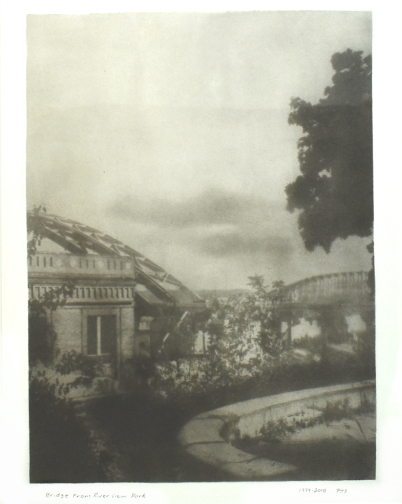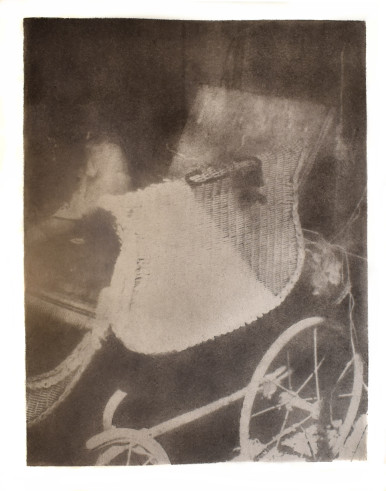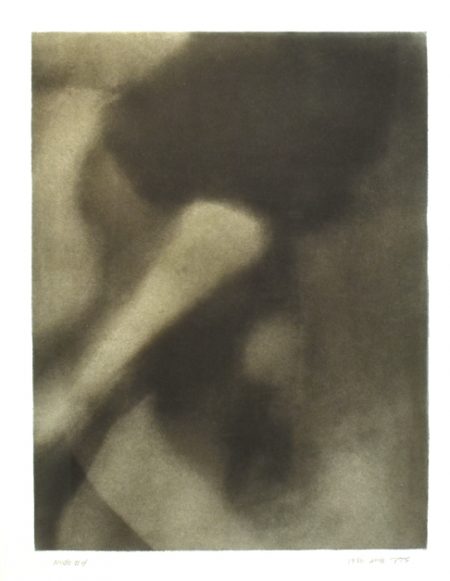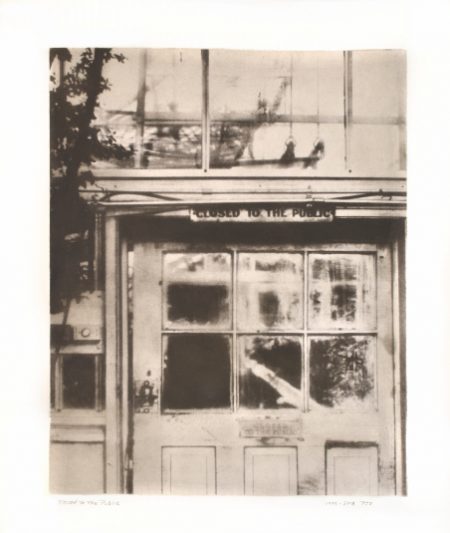When I walked into native Cincinnatian PJ Sturdevant’s 1exhibition, “Remembrances,” at Xavier University, my head exploded with a jumble of images of the work of other photographers. The title of the show, thus, was an apt one for my reaction.

But being able to reel off the names of other photographers (in no particular order, Jean-Eugène-Auguste Atget (French, 1857-1927), Berenice Abbott (1898-1991), Walker Evans (American, 1903-1975), Paul Strand (American, 1890-1976), Jacques Henri Lartigue (French, 1894-1986), Alvin Langdon Coburn, (British, 1882-1966), Edward Steichen (American, 1879-1973), Alfred Stieglitz (American, 1864-1946) who might have inspired or influenced Sturdevant’s style isn’t the way most visitors will interpret the theme of this exhibition, and rightly so.
The wall text explains Sturdevant is exploring “his feeling and memories of the past through the creative process. Deep tonal contrasts intensify and add mystery to the subjects; while soft edges nod to his dream-like remembrances of the past.”
The show consists almost entirely of architectural photographs shot in Cincinnati between in the late 1970s and 1980. They were chosen from Sturdevant’s archive (Remembering 1975-1980)of more than a thousand 35 mm negatives shot then and printed this year specifically for FotoFocus using the Bromoilprocess. 2

The use of the Bromoil process links him directly to the Pictorialists3of the late 19thand early 20thcenturies instead of all his antecedents with tenuous resemblances to his work that I see. Sturdevant makes a declarative statement about this in his explanation of the Bromoil process.
Bromoil was one the favorite and beloved processes of the Pictorialistsand salon exhibition photographers during the first half of the twentieth century. No show of the photographic art of the Pictorialists was without lovely, soft and painterly Bromoil prints.4

The look achieved by the Bromoil process heightens the nostalgic feeling of Sturdevant’s pictures from decades ago. That process also makes the photos of the Isaac M. Wise Temple, CincinnatiArt Museum, Taft Museum of Art, and Cincinnati City Hall done this year seem to be of another time.

Regardless of what technique Sturdevant might have chosen, the pictures are compelling, even in their ordinariness. One example is 913 Martin Street, which documented the door of the Free Pentecostal Holiness Church. The church is gone, and the street has been renamed Adams Crossing in a marketing ploy to turn the area, just east of Sawyer Point Park, into a desirable neighborhood for upscale condos.
Sturdevant’s image begs for a story, as do all of his photographs. At the Free Pentecostal Holiness Church, I can imagine a congregation of women in housedresses, men in shirtsleeves and vests, kids with skinned knees, kicking against the pew or bench, eager to be out-of-there on a summer Saturday or Sunday night. They could be the kids Sturdevant photographed for Martin Street Children, standing on the sidewalk with smiles on their faces in front of boarded up windows, a sign that Martin Street would soon be gone.

There are some images that could have come from anywhere, for example, Behind the Fence. Two garbage cans can be seen behind a chain link fence, its diamond pattern making a skewed grid overlaid on the scene. In a fairly high-altitude flight of fancy, I anthropomorphized the garbage cans, turning them into a couple, a barrel-chested man on the left and on the right, a smaller and more delicate figure with the familiar striped undulations on the side of the can slightly angled. I love the detail of an actual chain, securing something, behind the fence.

Most of Sturdevant’s pictures are of Cincinnati, although many could be anywhere as he is really documenting the urban experience, even when he identifies the location, such as Martin St. Steps andBridge from River View Park.

Sturdevant includes a photo of an arcade in what I take to be a Beaux-Arts building. He tells us that it is in Paris, but I’m certain a similar arcade exists somewhere in Cincinnati. Our only clue about the location may come from a minor detail: a man perched on a ledge and engrossed in whatever he’s reading, I imagine a newspaper. It’s only the man’s headgear that I see as a beret that slyly suggests Paris.

There are several non-architectural images, including Forgotten Pram, Nude #4,Cindy’s Loom, and Lake Snowden Athens Co. Ohio 1, I won’t opine why he included these photos, except to note that they testify that there other subjects in his large archive.
I’m not sure Sturdevant intends the viewer to find humor in his images, as I do in Behind the Fence and Paris,but sometimes it’s hard to miss, for example, Forgotten Pram. The title might be interpreted as a double-entendre. When was the last time you saw a pram, short for perambulator? Surely Mary Poppins had one. But the pram, as a type of baby carriage, is almost forgotten, but this one might have inadvertently been left behind, forgotten, but where’s the babe?

There is a strong abstract quality to this image, something that can be seen in other Sturdevant photographs, including Cincinnati Doorwhere the door has just become a dark rectangular shape with a freely brushed surround. It’s nearly impossible to discern the body in Nude #4; it’s more a composition of light and dark.
Sturdevant could have simply printed the black-and-white negatives—and I think the impact of the images would have been the same—but the Bromoil process is antiquated, and just the thing to illustrate a bygone era.

–Karen S. Chambers
“Remembrances by PJ Sturdevant,” Xavier University Art Gallery, A. B. Cohen Center, 1658 Musketeer Dr., Cincinnati, OH 45207-7311, phone: 513-745-3811, fax: 513-745-1098, www.xavier.edu/art. Hours: Mon.-Fri., 10:00 am-4 pm and by appointment. Through October 27, 2018.
END NOTES
1 Sturdevant holds “degrees in mechanical engineering and applied science from the University of Cincinnati and Miami University. Sturdevant studied photography in the early 1970s with Walt Burton at Camera Works. After a 45-year career in industry, he has returned to his love of photography specializing in the Bromoil process.” “About PJ Sturdevant,” pj-sturdevant.com.
2 “About The Bromoil Process,”“Bromoil was one the favorite and beloved processes of the Pictorialists and salon exhibition photographers during the first half of the twentieth century. No show of the photographic art of the Pictorialists was without lovely, soft and painterly Bromoil prints.
“In addition to the archival quality provided by the use of lithographic ink additional control of contrast and texture is provided using the Bromoil process. Starting with a digital image provides an additional level of abstraction that is more difficult to achieve with the traditional darkroom technique.
“The traditional Bromoil process begins with a silver bromide print created from a silver negative. The solution to creating silver bromide prints from digital images is to produce full size negatives using a high quality inkjet printer. The density, contrast, and size of the negative can be controlled resulting in a quality negative. The resulting negative is then used to produce a direct contact silver bromide print used to produce the final Bromoil print.
“In addition to the archival quality provided by the use of lithographic ink additional control of contrast and texture is provided using the Bromoil process.
“The following steps are used to produce each of my Bromoil prints:
- A black and white silver bromide print is created using a full-size inkjet negative and developed using the traditional chemical darkroom printing processes.
- The silver print is then bleached and tanned with appropriate chemicals removing the silver, washed and dried leaving a matrix of gelatin.
- After re-soaking and wiping off all surplus surface water the gelatin matrix has now absorbed water in direct proportion to the lights and darks of the original image.
- Lithographic ink is then spread evenly over the print. The oily printing ink adheres to the matrix in the dryer shadow areas and is repelled in the water-swollen highlights.
- Specialized brushes are then used to further distribute the ink, building contrast and adding a subtle texture to the final print.
- The result is a single (one-of-a-kind) Bromoil print.”
“About The Bromoil Process,” pj-sturdevant.com.
3“Pictorialismis the name given to an international style and aesthetic movement that dominated photographyduring the later 19th and early 20th centuries. There is no standard definition of the term, but in general it refers to a style in which the photographer has somehow manipulated what would otherwise be a straightforward photograph as a means of “creating” an image rather than simply recording it. Typically, a pictorial photograph appears to lack a sharp focus (some more so than others), is printed in one or more colors other than black-and-white (ranging from warm brown to deep blue) and may have visible brush strokes or other manipulation of the surface. For the Pictorialist, a photograph, like a painting, drawing or engraving, was a way of projecting an emotional intent into the viewer’s realm of imagination.” “Pictorialism,” Wikipedia.
4 “About The Bromoil Process,” pj-sturdevant.com.